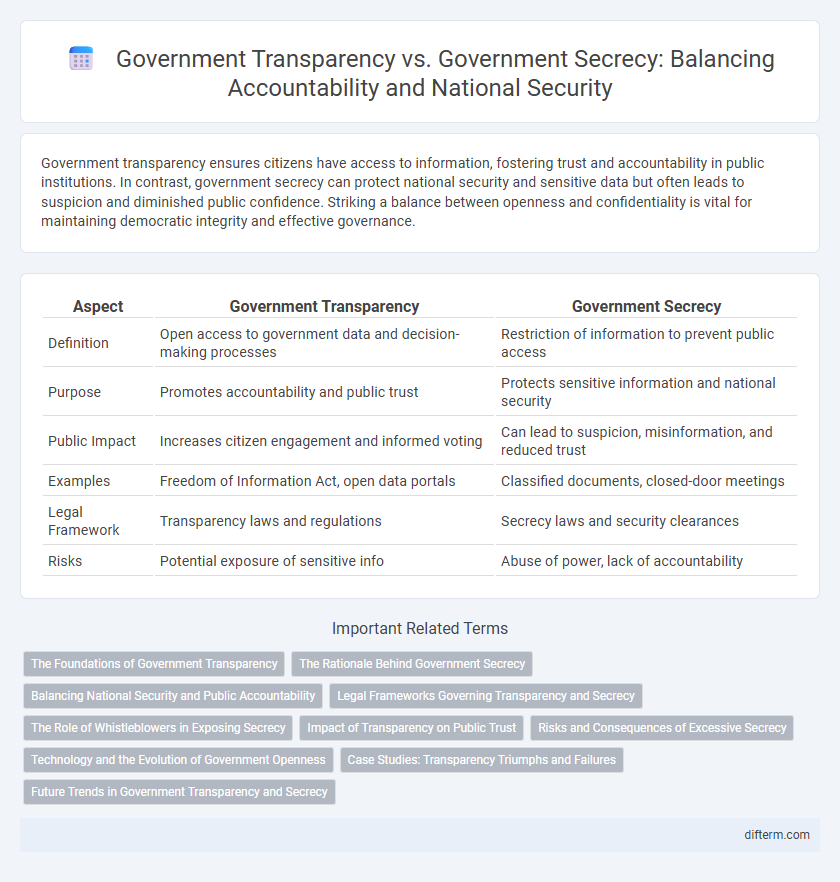Government transparency ensures citizens have access to information, fostering trust and accountability in public institutions. In contrast, government secrecy can protect national security and sensitive data but often leads to suspicion and diminished public confidence. Striking a balance between openness and confidentiality is vital for maintaining democratic integrity and effective governance.
Table of Comparison
| Aspect | Government Transparency | Government Secrecy |
|---|---|---|
| Definition | Open access to government data and decision-making processes | Restriction of information to prevent public access |
| Purpose | Promotes accountability and public trust | Protects sensitive information and national security |
| Public Impact | Increases citizen engagement and informed voting | Can lead to suspicion, misinformation, and reduced trust |
| Examples | Freedom of Information Act, open data portals | Classified documents, closed-door meetings |
| Legal Framework | Transparency laws and regulations | Secrecy laws and security clearances |
| Risks | Potential exposure of sensitive info | Abuse of power, lack of accountability |
The Foundations of Government Transparency
Government transparency ensures public access to information, fostering accountability and trust in democratic institutions. The foundations of government transparency include legal frameworks like freedom of information laws and proactive disclosure policies that mandate openness in governmental operations. Balancing transparency with necessary secrecy protects national security while upholding citizens' rights to monitor and evaluate government actions.
The Rationale Behind Government Secrecy
Government secrecy is often justified by the need to protect national security, safeguard sensitive intelligence, and maintain diplomatic relations. Concealing information helps prevent threats, such as terrorism or espionage, that could jeopardize public safety and state stability. However, this rationale must be balanced against the public's right to transparency and accountability to ensure democratic governance.
Balancing National Security and Public Accountability
Balancing national security and public accountability requires transparent government practices that protect sensitive information without undermining public trust. Effective frameworks ensure classified data safeguards critical operations while enabling oversight mechanisms that hold officials accountable. Transparent disclosures enhance democratic legitimacy, yet strategic secrecy remains essential to protect citizens from security threats.
Legal Frameworks Governing Transparency and Secrecy
Legal frameworks governing government transparency and secrecy include freedom of information laws, classified information statutes, and national security regulations that balance public access and confidentiality. These laws define the scope and limits of information disclosure to ensure accountability while protecting sensitive data critical to state security. Courts and oversight bodies play a crucial role in interpreting these frameworks and resolving disputes over information access.
The Role of Whistleblowers in Exposing Secrecy
Whistleblowers play a critical role in exposing government secrecy by revealing hidden misconduct, corruption, and policies that undermine public trust. Their disclosures enable increased transparency, holding officials accountable and fostering democratic governance. Protections for whistleblowers are essential to encourage reporting and safeguard the integrity of governmental institutions.
Impact of Transparency on Public Trust
Government transparency significantly enhances public trust by providing citizens with accessible information about decision-making processes and policies. Transparent governance reduces corruption risks and encourages civic engagement, leading to stronger democratic institutions. In contrast, excessive government secrecy fosters suspicion, undermines accountability, and erodes the legitimacy of public officials.
Risks and Consequences of Excessive Secrecy
Excessive government secrecy risks eroding public trust by obscuring accountability and enabling corruption. A lack of transparency can hinder informed citizen participation and stifle democratic governance, leading to policy decisions unchallenged by public scrutiny. Such secrecy may also impair oversight institutions, weakening checks and balances essential for preventing abuse of power.
Technology and the Evolution of Government Openness
Advancements in technology have significantly reshaped government transparency by enabling greater access to public data through digital platforms, open-source tools, and real-time information sharing. Despite these innovations, government secrecy persists due to cybersecurity concerns, national security priorities, and bureaucratic resistance to full disclosure. The evolution of government openness now hinges on balancing technological capabilities with the imperative to protect sensitive information while fostering accountability and civic engagement.
Case Studies: Transparency Triumphs and Failures
Case studies reveal that government transparency enhances public trust, as demonstrated by the successful Open Government Initiative in the United States, which improved citizen engagement and accountability through accessible data portals. Conversely, the failure of the UK's Windrush scandal highlighted the dangers of excessive government secrecy, where lack of transparency led to wrongful detentions and public outcry. These examples emphasize the critical balance between openness and confidentiality to ensure effective governance and safeguard democratic principles.
Future Trends in Government Transparency and Secrecy
Emerging technologies such as blockchain and AI-driven data analytics are poised to enhance government transparency by enabling secure, real-time access to public records and decision-making processes. Despite these advances, rising concerns over national security and cyber threats are driving governments to maintain or increase secrecy in critical areas. Future trends indicate a dynamic balance where transparency initiatives will expand in non-sensitive sectors, while secrecy protocols will tighten around intelligence and defense operations.
government transparency vs government secrecy Infographic

 difterm.com
difterm.com